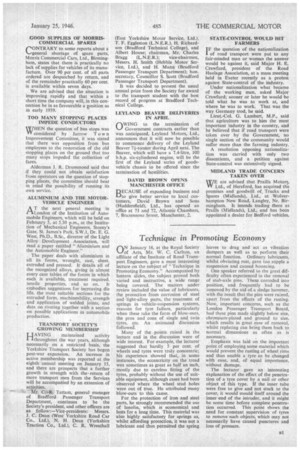Technique in Promoting Economy
Page 27

If you've noticed an error in this article please click here to report it so we can fix it.
ON January 16, at the Royal Society of Arts, Mr. W. C. Carlton, an affiliate of the Institute of Road Transport Engineers, gave a most interesting lecture on the subject of " Technique in Promoting Economy." Accompanied by lantern slides, the subject proved both varied and instructive, a wide range being covered. The matters under review included the value of lubricants, the protection from corrosion of steel and light-alloy parts, the treatment of springs in vehicle-suspension systems, reasons for tyre failure, particularly when these take the form of blow-outs, the pros and cons of single and, twin tyres, etc. An animated discussion followed.
Many of the points raised in the lecture and in the discussion were of wide interest. For example, the lecturer suggested that hardly 5 per cent. of wheels and tyres were truly concentric; his experience showed that, in some instances, the eccentricity on the tread was sometimes as great as half an inch, mostly due to careless fitting of the tyres, probably without the use of suitable equipment, although cases had been observed where the wheel stud holes were out of true. He attributed many blow-outs to this cause.
For the protection of iron and steel parts, he strongly recommended the use of lanolin, which is economical and lasts for a long time. This material was also highly satisfactory for springs as, whilst affording protection, it was not a lubricant and thus permitted the spring leaves to drag and act as vibration dampers as well as to perform their normal function. Ordinary lubricants, whilst obviating rust, gave too supple a suspension and caused bouncing.
One speaker referred to the great difficulty often experienced in the removal of stub-axle pins. These corroded into position, and frequently had to be ' removed by the aid of a sledge hammer, with the result that the pins were ruined, apart from the effects of the rusting. Now, important concerns, such as the London Passenger Transport Board, had these pins made slightly below size, chromium-plated and ground to size, which results in great ease of removal, whilst replating can bring them back to normal dimensions as often as is necessary.
Emphasis was laid on the important point of employing some material which would prevent the rusting of wheel rims and thus enable a tyre to be changed with ease, and, of equal importance, without damage.
The lecturer gave an interesting explanation of the effect of the penetration of a tyre cover by a nail or other object of this type. If the inner tube were free to give and not stuck to the cover, it would mould itself around the inner end of the intruder, and it might be some time before complete penetration occurred. This point shows the need for constant supervision of tyres to remove such objects, which may not necessarily have caused punctures and loss of pressure.




























































